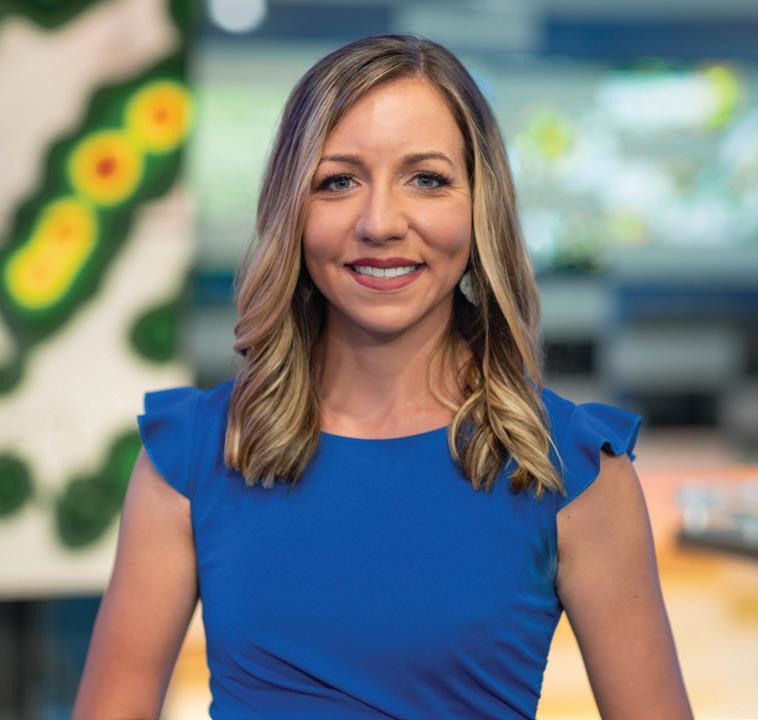
4 minute read
A ROARING SUCCESS

Photo courtesy of WLWT.
EXPANDED HORIZONS LEAD TO FORECASTING WEATHER
By Richelle Thompson
When the newspaper arrived in her childhood home, Katie Donovan ’14, went straight for the weather report. And when a storm rolled up, Donovan watched from the porch, fascinated. She and her dad watched weather forecasts on TV, but it wasn’t until her experience at the Mount that the clouds— proverbially—parted.
Encouragement from professors and staff, and an introduction to meteorology class, changed the trajectory of her career. In August, Donovan returned to her hometown of Cincinnati to offer the weekend forecasts as a meteorologist for WLWT-TV, the same channel she watched as a child.
Homeschooled through high school, Donovan was attracted to the Mount for its size and proximity to home as well as its physical therapy and athletic training programs. But then she discovered the communications program. At the time, the Mount had a Success Coaching program, with faculty mentoring freshmen. “My success coach really helped me work the questions of what I wanted to do in my life,” Donovan says. “Also, my advisor, Dr. Linda Jackson, was vital in walking me through the communications program and helping me discover where I was headed and what options there were with the major.” After she graduated, Donovan earned a certificate in broadcast meteorology from Mississippi State University and worked her way through several TV stations. In Colorado Springs, Colorado, she covered some major weather stories, including historic hail storms and a rare Colorado bomb cyclone. “It’s a privilege to walk with people in their time of need, to be able to tell them what to expect and offer some calm assurance,” she says. Colorado offered some sunny skies for Donovan too. She met her now-husband, Andrew, and they have a daughter, Magnolia, who is almost two. Donovan credits the Mount with giving her the skills and the courage to
expand her horizon. The small classroom size and individual attention gave her the opportunity to develop and stretch her leadership skills. And the relationships that she built with professors and students provided a vital network.
Her advice to MSJ students today is the same advice she received a decade ago: “Be fearless. Don’t be afraid to take a risk. If you’re on the fence about something, don’t be afraid to give it a try. People encouraging me to try new things when I was in college was very influential for where I am in my career,” Donovan says. “I owe a lot to that school.”

Kristina Sattler in Microbiology lab.
Photo by Mark Byron.
AN INTERNSHIP WITH NASA
Kristina Sattler ’21, was one of just 11 students nationwide selected for NASA’s prestigious Space Life Sciences Training Program (SLSTP), where she virtually studied and performed research with scientists at NASA’s Ames Research Center in California’s Silicon Valley.
Sattler, a Cincinnati native who graduated summa cum laude from the Mount with a degree in biology and is now pursuing a Doctor of Philosophy in Molecular, Cellular and Developmental Biology at The Ohio State University, worked over the summer as a NASA intern studying the effects of spaceflight and radiation on the central nervous system.
“When I was offered a place in the selective NASA program, I was beyond ecstatic,” Sattler says. “I think at some point every kid dreams of working with NASA, so it was definitely a dream come true. Speaking to friends at other schools, the amazing experience I had at the Mount is unheard of anywhere else.”
Originally planning on studying prephysical therapy at the Mount, Sattler found her passion for research while working in the lab of Kelly Crowe, Ph.D., assistant professor of Biology at the Mount.
“I worked with Dr. Crowe for over two years, and having that experience has allowed me to more comprehensively understand the world of biomedical research, not only in the lab, but in the classroom as well,” Sattler says.
The objective of the NASA program is to produce technically skilled scientists and engineers with the potential to become leaders in the U.S. Space Program by providing a glimpse into the many disciplines that are required to conduct biological research in space.






